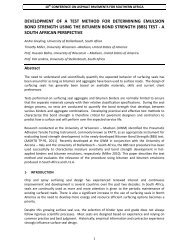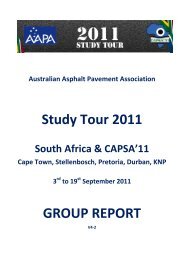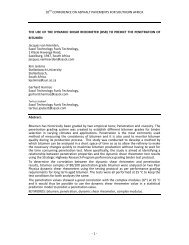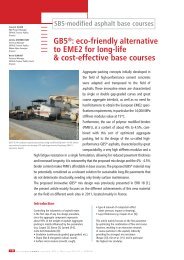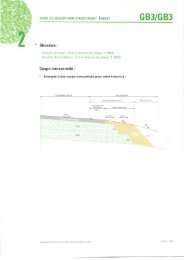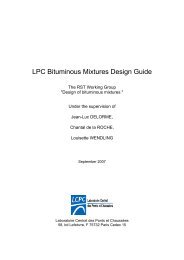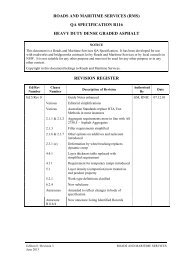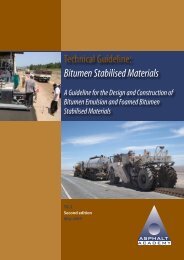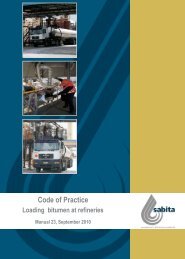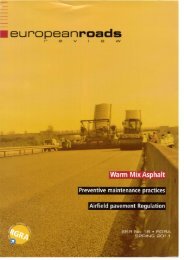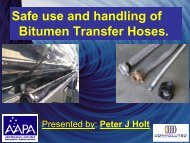Guide to the safe handling of solvents in a bituminous ... - Aapaq.org
Guide to the safe handling of solvents in a bituminous ... - Aapaq.org
Guide to the safe handling of solvents in a bituminous ... - Aapaq.org
- No tags were found...
Create successful ePaper yourself
Turn your PDF publications into a flip-book with our unique Google optimized e-Paper software.
• Temperature - Although b<strong>in</strong>der harden<strong>in</strong>g occurs at roomtemperature 2, 14 , a higher temperature dur<strong>in</strong>g contact between <strong>the</strong>b<strong>in</strong>der and <strong>the</strong> solvent results <strong>in</strong> a greater harden<strong>in</strong>g effect 2, 10, 17 .Extraction method ASTM D2172 (Method B) employs a highertemperature than ASTM D2172 (Method A);• Light - The absence <strong>of</strong> light dur<strong>in</strong>g contact between <strong>the</strong> b<strong>in</strong>der and <strong>the</strong>solvent reduces <strong>the</strong> harden<strong>in</strong>g effect 2, 18 . RILEM Technical CommitteeTC 5611 has recommended that extracted b<strong>in</strong>der solution be kept <strong>in</strong><strong>the</strong> dark until <strong>the</strong> recovery is completed;• Oxygen - A lower partial pressure <strong>of</strong> oxygen dur<strong>in</strong>g contact between<strong>the</strong> b<strong>in</strong>der and <strong>the</strong> solvent reduces <strong>the</strong> harden<strong>in</strong>g effect 2 ;• Different b<strong>in</strong>der-aggregate types exhibit different extents <strong>of</strong> b<strong>in</strong>derharden<strong>in</strong>g for <strong>the</strong> same extraction and recovery conditions 2 .Conclusions regard<strong>in</strong>g <strong>the</strong> effects <strong>of</strong> b<strong>in</strong>der harden<strong>in</strong>g imply that• The lowest possible temperature should be employed dur<strong>in</strong>g <strong>the</strong>extraction-recovery phase, i.e. <strong>the</strong> hot extraction method, ASTMD2172 (Method B), and <strong>the</strong> high temperature Abson recoverydistillation, ASTM D1856, would be disadvantageous from a b<strong>in</strong>derharden<strong>in</strong>g perspective;• The time <strong>of</strong> contact between solvent and b<strong>in</strong>der should be limited <strong>to</strong><strong>the</strong> shortest possible time that allows for effective extraction <strong>of</strong> <strong>the</strong>b<strong>in</strong>der from <strong>the</strong> hot mix asphalt.Incomplete removal <strong>of</strong> <strong>the</strong> solvent from <strong>the</strong> recovered b<strong>in</strong>derResidual solvent rema<strong>in</strong><strong>in</strong>g <strong>in</strong> <strong>the</strong> recovered b<strong>in</strong>der after solventrecovery results <strong>in</strong> a reduced stiffness for <strong>the</strong> recovered b<strong>in</strong>der.The presence and concentration <strong>of</strong> residual solvent <strong>in</strong> <strong>the</strong> b<strong>in</strong>dercan be moni<strong>to</strong>red us<strong>in</strong>g:• Infrared spectroscopy 9, 19 ;• Gas chroma<strong>to</strong>graphy 20 ;• High performance liquid chroma<strong>to</strong>graphy.Some researchers 14, 21 have shown that <strong>the</strong> Abson distillation(ASTM D1856) results <strong>in</strong> greater quantities <strong>of</strong> residual solventpresent <strong>in</strong> <strong>the</strong> recovered b<strong>in</strong>der compared <strong>to</strong> <strong>the</strong> Rotavapor20



